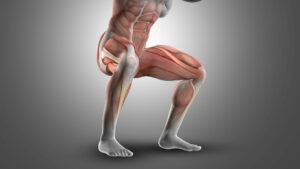Squats are an incredibly effective exercise for strengthening and toning various muscle groups in the body. One of the fascinating aspects of squats is how they engage the core muscles, leaving you with a feeling of deep activation and stability. In this article, we will delve into the reasons behind why squats make you feel your core muscles engaged. We will explore the anatomy of the core, the biomechanics of squats, and the specific muscles involved. So, let’s dive in and uncover the secrets of core activation during squats.
Feeling core muscles engaged in squats.
Squats engage the core muscles, including the rectus abdominis, obliques, transverse abdominis, and erector spinae, to stabilize the torso and maintain proper form. This enhances alignment, reduces injury risk, and allows for greater force generation. Activating the core adds strength and stability, enabling you to lift heavier weights. Additionally, core engagement improves body control and balance during squats, especially with challenging variations. Feeling your core muscles engaged indicates proper form, stability, and performance for optimal benefits.
Squats engage and activate several muscle groups.
Squats are a fundamental exercise that targets the lower body muscles, including the quadriceps, hamstrings, and glutes.
However, they also engage and activate several other muscle groups, particularly the core muscles. The core muscles consist of the rectus abdominis, obliques, transverse abdominis, and erector spinae muscles.
Their primary role during squats is to stabilize your torso and maintain an upright posture throughout the movement.
Form and alignment.
Proper form and alignment are crucial for performing squats effectively and safely.
When you execute a squat, the core muscles engage to ensure that your spine remains in a neutral position and that your hips, knees, and ankles are properly aligned.
This alignment minimizes the risk of injury and enhances the overall effectiveness of the exercise by enabling you to generate more force and power from your lower body.

Engagement of the core muscles.
The engagement of the core muscles during squats serves multiple purposes.
Firstly, it contributes to maintaining the proper form and alignment of your body.
By stabilizing your torso, the core muscles help prevent your spine from collapsing forward or rounding, which could lead to excessive stress on the lower back.
This stability is especially important as you increase the weight or intensity of your squats.
Imagine performing a heavy back squat. As you descend into the squatting position, your core muscles engage to stabilize your spine and prevent it from flexing forward.
This stabilization allows you to maintain a strong and aligned posture, enabling you to lift the weight more efficiently and safely.
Secondly, the activation of the core muscles adds an extra element of strength and stability to the squatting movement.
Your core serves as a solid foundation for generating force and power from your lower body.
A strong and stable core allows you to transfer the force generated by the lower body muscles more effectively, resulting in improved squat performance and the ability to handle heavier loads.
For instance, consider performing a barbell front squat. The front-loaded position places greater demands on the core muscles for stability.
As you descend into the squat, your core engages to maintain an upright posture and prevent your upper body from tilting forward. This engagement not only helps you lift the weight but also promotes balance and control throughout the movement.
Lastly, the core muscles contribute to overall body control and balance during squats. By engaging and activating these muscles, you enhance your ability to stabilize your body during the exercise.
This is particularly crucial when performing squats with added challenges, such as using weights or attempting variations like single-leg squats.
For example:
Let’s take the example of a pistol squat, which is a type of single-leg squat. During a pistol squat, your core muscles play a significant role in maintaining balance and control as you lower your body down on one leg.
The core stabilization allows you to control the movement, prevent excessive rotation, and ensure that your body remains in a stable position throughout the exercise.
Here’s a tabular breakdown on why squats engage the core muscles, how they do so, examples, and key considerations:
| Aspect | Why Squats Engage the Core Muscles | How Squats Engage the Core Muscles | Examples | What to Consider |
|---|---|---|---|---|
| Why? | – Maintain proper form and alignment | – Stabilize the torso to prevent spine collapse or rounding | – Traditional squats | – Focus on maintaining a neutral spine position |
| – Weighted squats | – Use a weight that challenges you but allows for proper form | |||
| – Front squats | – Keep the core engaged to prevent the upper body from tilting forward | |||
| – Single-leg squats (e.g., pistol squats) | – Concentrate on balance and control, engaging the core to stabilize the body throughout the movement | |||
| How? | – Stabilize the torso | – Activate rectus abdominis, obliques, transverse abdominis, and erector spinae muscles | – Plank position during squats | – Engage the core by contracting the abdominal muscles and maintaining a flat back position |
| – Anti-rotation exercises (e.g., Pallof press) | – Use resistance to challenge core stabilization, such as resisting rotation forces | |||
| Examples | – Regular squats | – Maintain an upright posture | – Squats with medicine ball twists | – Incorporate a medicine ball twist at the top of the squat to engage the obliques |
| – Squats with cable or resistance band exercises | – Attach a cable or resistance band to your body and perform squats, resisting the pulling force | |||
| What to Consider | – Focus on maintaining a neutral spine position | – Engage the core throughout the entire movement | – Squat variations with added challenges (e.g., Bulgarian split squats, sumo squats) | – Gradually progress to more advanced squat variations, ensuring proper form and core engagement |
| – Functional squats, such as squatting while lifting or carrying objects | – Practice squats in functional movements, engaging the core to maintain stability and control | |||
| – Overhead squats (with weights) | – Engage the core to stabilize the body and prevent excessive forward or backward leaning |
This table provides a summary of why squats engage the core muscles, how they do so, example variations, and important considerations to keep in mind. Incorporating these elements into your squatting routine can help you maximize the benefits of the exercise and promote proper form, stability, and control.
Conclusion
In summary, squats primarily target the lower body muscles but also engage and activate the core muscles. The core’s involvement during squats is essential for maintaining proper form, stability, and control.
It helps to align the spine and body, enhances strength and stability, and contributes to overall body control and balance.
Feeling your core muscles engaged during squats indicates that you are maintaining proper form and stability, allowing you to perform the exercise more effectively and derive maximum benefits.
Whether it’s a traditional squat, a weighted variation, or a single-leg squat, the core’s involvement is integral to your squatting performance and overall fitness journey.

Hey there, it’s Mike Rrsq, the Editor-in-Chief over at Jsquat.com, and I’m absolutely obsessed with all things squat fitness! I’ve been lucky enough to get some serious recognition for my work in this field. With a solid background in the fitness and wellness industry, I’ve been there right from the get-go, helping shape this website into what it is today.
You see, I’m not just the boss around here; I’m also a passionate contributor. I love sharing my insights through my articles, and trust me, they’re not your run-of-the-mill stuff. Each piece I write is a labor of love, filled with my expertise and real-world experience in the fitness universe. So, if you’re into fitness and looking for some inspiration, you’re in the right place!

